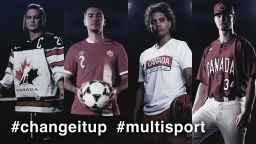Pushing for a multi-sport approach to kids’ sport and activity
Wednesday, August 15, 2018 - 09:00

We know that today’s kids face a myriad of obstacles to getting active and developing physical literacy. From obsession with smartphones and video games, to increasing confinement in urban spaces, kids today are facing challenges that most of their parents never had to confront.
As a consequence, for better or for worse, organized sport and activity has become the main venue for many kids to explore physical activity. The problem is that we don’t always do organized sport well. As parents, coaches, and program organizers, we often unwittingly create conditions that do more to discourage kids in activity than encourage them. A primary example is the tendency to push kids to specialize too early in one sport or activity, especially if they show even a glimmer of possible talent before they enter their teens.
The Risk of Premature Specialization
Premature specialization is dangerous because it has been linked to injury, burnout, and dropout (Jayanthi et al. 2013, Jayanthi et al. 2015, Fraser-Thomas et al. 2005). The antidote to premature specialization is to promote a multi-sport approach, where kids essentially dabble in a wide range of sports and activities prior to early adolescence. Even if kids are certain that they want to go to the Olympics or enter the ranks of professional sport one day, evidence points to the multi-sport approach as the best way of getting there. Research suggests that participating in a variety of activities and sports in childhood leads to better skill development, less injury, less burnout, and less dropout in the long term (Fraser-Thomas & Côté 2008, Jayanthi et al. 2012, Bridge & Toms 2013).
But it’s a hard sell. Too many parents and coaches are not aware of the research, and many of them have grown up believing the myth that early specialization is the key to success in everything, especially sports.
Play More Sports Campaign
Enter the Play More Sports campaign—a joint public education effort by Active for Life and four Canadian national sport organizations to promote kids’ multi-sport in Canada. Built around a video PSA and a companion website, it features elite Canadian athletes demonstrating their versatility in different sports as they describe the benefits they experienced from pursuing a variety of activities as kids. The website also provides links to major pieces of research supporting the multi-sport approach, together with social media and email links to make it easy to share the site and the video with friends, family, and colleagues.
Funded by the Canadian Olympic Committee, the video and website are the product of a unique collaboration between multiple sport partners including Baseball Canada, Canada Basketball, Hockey Canada, Canada Soccer, and Active for Life. The partners hope parents, coaches, and others sympathetic to multi-sport will share the website and the video widely, and thereby help to create a sea-change in kids’ sport and activity in Canada.
Responding to the Resistance
Since the launch of the campaign, some people have commented that multi-sport is a nice idea, but it’s not feasible at the community level for most kids and families. Most programs and clubs still don’t allow for kids to easily sample other sports and activities through the year. But this is precisely the point of the campaign: to get everyone thinking about multi-sport so the necessary programming changes will start to happen.
Let’s be clear: we are talking about a major paradigm shift in kids’ community sport and activity. It’s not likely to happen overnight. Everyone involved in kids’ programming needs to hear the multi-sport message, and then we need to start pushing in the same direction. But if enough parents and coaches start to embrace multi-sport, the necessary changes are sure to happen.
This is the first in a three part blog series on the value of a multisport approach. SIRC readers can look forward to learning more about promising practices to support a multi-sport approach in October 2018, and insights on implementation from sport leaders in January 2019.
About the Author - Jim Grove is a senior contributing editor at Active for Life and a consulting editor to national sport organizations on physical literacy and Long-Term Athlete Development. He has 20 years experience coaching youth soccer along with NCCP certification as a youth soccer coach.
References
Bridge, Matthew W. & Martin R. Toms (2013). The specialising or sampling debate: a retrospective analysis of adolescent sports participation in the UK. Journal of Sports Sciences, 31:1, 87-96.
Fraser-Thomas, Jessica, Jean Côté and Janice Deakin (2005). Youth sport programs: an avenue to foster positive youth development. Physical Education and Sport Pedagogy, Vol. 10, No. 1, pp. 19–40.
Fraser-Thomas, Jessica and Jean Côté (2008). Examining Adolescent Sport Dropout and Prolonged Engagement from a Developmental Perspective. Journal of Applied Psychology, 20:318-333.
Jayanthi, Neeru et al. (2013). Specialization in Young Athletes: Evidence-Based Recommendations. Sports Health: A Multidisciplinary Approach. Volume: 5 issue: 3, page(s): 251-257.
Jayanthi, Neeru et al. (2015). Sports-specialized intensive training and the risk of injury in young athletes: a clinical case-control study. American Journal of Sports Medicine, 43(4):794-801.